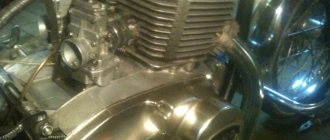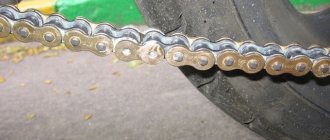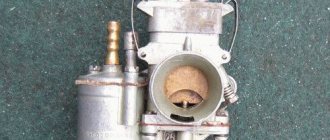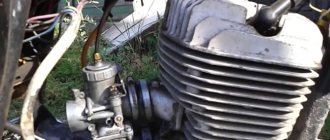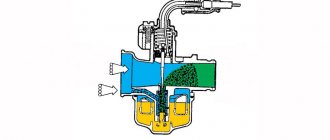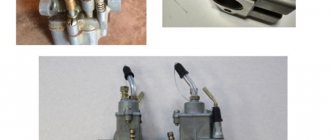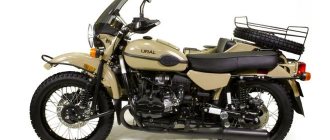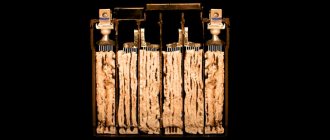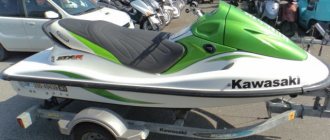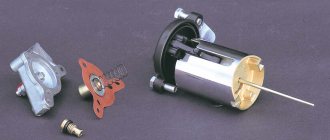Rear light for Voskhod with ultra-bright LEDs. Sent by kadet.
Starting spark delay device. Sent by kadet.
Article on installing a battery on ZiD motorcycles. Sent by kadet.
An article on making an air filter from oil filter elements. Sent by kadet.
Article on the manufacture of progressive suspension for the ZiD-50. Sent by kadet.
Diagram of a universal turn signal relay. Posted by Morgan.
Conversion of the 6 volt generator G-427 into a 12 volt one. Sent by SlavaR.
The design and principle of operation of the K65 carburetor. Sent by kadet.
The design and principle of operation of the K62 carburetor. Sent by kadet.
The design and principle of operation of the Jikov carburetor. Sent by kadet.
Marking, dimensions and applicability of bearings. Sent by cadet.
Technical characteristics of motorcycles Voskhod, Izh, Sova. Sent by cadet.
Off-road ZDK-200 2ShP. Test, description, characteristics. Sent by cadet.
Mokik ZiD 50-01 with a Chinese Lifan engine. Characteristics, test. Sent by cadet.
Tests of Kovrov ATVs with a 50 cm3 engine. Sent by cadet.
Photos of vintage motorcycles produced by Kovrov. Sent by cadet.
Marking of oil seals, table of their interchangeability. Sent by cadet.
Oil tests for 2T engines, oil characteristics. Sent by cadet.
History, repair and diagnostics of contactless ignition. Sent by kadet.
Article on installing a car signal on Voskhod. Sent by cadet.
An article on disassembling and repairing the front fork of the K-175 and Kovrovets. Sent by cadet.
Article on repairing the ZiD-200 engine of the Owl motorcycle. Sent by cadet.
Article on repairing an alternator. Sent by cadet.
Article on replacing the right crankshaft bearing without disassembling the engine Posted by kadet.
Electrical diagram of the ZiD-200 motorcycle. Sent by kadet.
Diagram of the switching-stabilization unit (BCS) 1MK211. Sent by kadet.
Motorcycles, motorcycle news, motorcycle diaries, motorcycle books and motorcycle selection
Operating instructions for motorcycle Voskhod 3
Operating instructions for motorcycle Voskhod 3.
The quality is very average, but readable if desired.
Contents of the operating instructions for the Voskhod 3 motorcycle
–Recommendations and warnings. –Introduction. -Technical data. –Basic rules and tips for operating the Voskhod-3 motorcycle. – Starting a cold engine. –Start a warm engine. -Putting the motorcycle in motion. -Motorcycle braking. –Control mechanisms and instruments. –Basic instructions on the design, disassembly and assembly of a motorcycle and recommendations for its care. –Removal and installation of the cylinder head, cylinder, piston rings, piston pin and piston. –Removal and installation of the clutch, motor transmission and kickstarter mechanism. –Removing the generator cover, speedometer gearbox and clutch release. –Removal and installation of the generator. –Removing and installing the gearbox oil seal and the right crankshaft oil seal. –Removing, installing and adjusting the carburetor. –Adjusting idle speed. – Complete disassembly of the engine. –Removal and installation of the crankshaft, bearings and crankshaft seals. – Disassembly, assembly and adjustment of the gearbox and shift mechanism. – Engine power system. –Exhaust noise muffler. -Chassis. – Shock absorber maintenance. –Removing and installing the front wheel. –Removing and installing the reverse gear chain and chain guard. –Adjusting chain tension. –Adjusting the brakes. –Electrical equipment. – Ignition adjustment. –High-voltage transformer B300B. – Electronic switch KET-IA. -Spark plug. –Headlight FG 133. –Central switch. – Motorcycle maintenance. –Recommendations for maintenance. –Lubricant table. –Possible malfunctions and ways to eliminate them. – Factory warranty and procedure for filing a complaint.
GENERAL INFORMATION
The charger UZS-P-6/12-6.3 UHL 3.1 “Rassvet-2”
is intended for charging and recharging batteries of passenger cars and motorcycles.
The Rassvet-2 charger produces a charge with a stabilized current in any of two modes:
In manual mode - charge 6 V and 12 V lead-acid batteries. In automatic mode - charge and recharge 12 V lead-acid batteries.
The Rassvet-2 charger has electronic protection against short circuits at its output and incorrect (polarity) connection to the battery terminals.
In addition, “Rassvet-2” allows you to determine the degree of charge of the battery, the serviceability of the battery, and the polarity of the battery terminals if there are no markings on them.
Charger UZ-12-6 UHL3.1 “Rassvet-2M”
Designed for charging and recharging serviceable acid-acid batteries of passenger cars with a rated voltage of 12V and a capacity of 40-75 Ah.
The device charges rechargeable batteries in a mode close to the “constant voltage” mode, which ensures their safety and durability. The Rassvet-2M charger has short circuit protection for electrical circuits.
Technical characteristics of chargers “RASSVET-2” and “RASSVET-2M”
DAWN-2
| DAWN-2M | ||
| Rated supply voltage, V | 220 | |
| frequency Hz | 50 | |
| Rated voltage of batteries being charged, V | 6 and 12 | 12 |
| Charging current in “4A max” mode, A – maximum – minimum | — | 4,5 1,0 |
| Charging current in “6A max” mode, A – maximum – minimum | — | 6,5 2,5 |
| Rated current value, A | 6,3 | — |
| Current adjustment is smooth, in the range, A | 0,1 -> 6,3 | — |
| Operating temperature range | -10 to +40 | |
| Overall dimensions, mm | 267x142x112 | |
| Weight, kg | 3,2 | 3,2 |
| Electricity consumption, kWh, no more | 0,16 | 0,12 |
.
Moto-Kovrov
The upgraded motorcycle received new 12-volt electrical equipment. The generator power was 65 W, which ensured reliable engine starting and good operation of the motorcycle's lighting and alarm systems in all engine operating modes.
All connections in electrical equipment were made using plug connectors enclosed in plastic blocks - they provided a more reliable connection and prevented the ingress of moisture and dirt.
To make it easier to control electrical devices on the motorcycle, new switches were used. On the left of the control panel there was a button for turning on the direction indicators, a horn button and a high-low headlight switch; the right remote control had an emergency engine shutdown key and a day-night switch; it was also the body of the coil-type throttle control handle . The sound signal had a sound pressure level of 105-110 decibels and was located under the headlight on a special bracket. The new relay ensured uninterrupted operation of the direction indicators.
The use of “European Beam” type optics with asymmetric light distribution in the new headlight housing ensured excellent visibility in low and high beam.
Above the headlight there was an instrument panel, the body of which was made of aluminum alloy until 1985, and since 1986 the modified body has become plastic.
The panel housed a speedometer, an ignition switch and two indicator lamps. A blue lamp indicated the inclusion of high beams, an orange lamp indicated the direction indicators. The instrument panel was protected from vibration by rubber bushings. The motorcycle also used a front brake signal switch, which was located in the front brake lever bracket. The new high steering wheel reduced driver fatigue during long trips. The use of new shapes, with thickenings at the ends of the clutch and front brake control levers, made it possible to reduce the risk of injury and stress on the driver’s hands while driving.
Completely new shaped handles on the steering wheel were made of black rubber. Modern rear-view mirrors in round plastic cases, on high racks, were screwed into new brackets for the clutch and front brake levers.
Rubber casings (corrugations) were introduced into the design of the front fork instead of steel cups, which provided reliable protection against moisture and dirt getting on the surface of the fork parts, and also reduced the cost of the product, reduced weight, and the motorcycle began to look more modern. Reflectors were installed in the aluminum headlight brackets. Curly rubber rings protected the headlight brackets from vibration. An anti-theft device was installed on the lower cross-arm of the fork, locked with a separate key. The front shield was height-adjustable (two positions), the fastening of which moved to the upper part of the movable fork pipes.
The first batches of motorcycles were equipped with a middle closure from the previous model, then a short, (without trunk) middle closure was used, which was painted in the color of the motorcycle or covered with chrome.
The front and rear mud flaps were made using new technologies using rollers rather than a stamp, as was the case before. A rubber mudguard and a new rear light bracket were installed on the rear shield. The frame featured folding driver's footrests with new rubber bands. The changes affected the rear suspension pendulum. The rear brake reaction support bracket was located at the bottom of the left stay, closer to the axis of the pendulum. In order to ensure the reliability of the brake mechanism assembly, as well as to prevent extraneous sound when using the rear brakes, jet thrust was used. The rear sprocket was now placed in a plastic housing consisting of two halves. The wheel hubs have a different appearance.
The base of the front and rear brakes, as well as the decorative plate of the front wheel, were painted matte black.
The muffler has acquired a more modern appearance. The new muffler plug was secured with two screws.
The fuel tank was changed, it became narrower and taller, but the capacity remained the same.
The main changes in the engine of the Voskhod-3M motorcycle affected the upper head of the connecting rod: instead of a bronze bushing, a needle bearing was used, which increased the durability of the crank mechanism. The Kickstarter of the new motorcycle was installed with a folding foot.
When painting motorcycles, the plant used a wide (as possible) color gamut of paint and varnish material, and there is no point in listing what colors the Voskhod-3M motorcycle was painted in.
To save money, at the end of production of the Voskhod-3M motorcycles, the lever brackets and the steering wheel mount were painted matte black.
The "Voskhod-3M" motorcycle was the base model for the small-scale production of the "Voskhod-3M Tourist" motorcycles,
"Voskhod-3M Sport",
"Voskhod-3M Lux"
and "Voskhod-3M Hunter",
as well as the production of the next model “Voskhod-3M-01”.
The set of tools remained the same, but a motorcycle first aid kit was not provided.
During the production of the Voskhod-3M motorcycle, 204 bearings from the People's Republic of Bulgaria, PAL spark plugs and spark plugs, and JIKOV-2928SE Czechoslovakia carburetors were used.
Additionally, the motorcycle was equipped with: a windshield, roll bars, side and rear luggage racks and a towbar for “Raccoon” and “Pony” motorcycle trailers.
The plastic windshield was secured with four screws. Two to the chrome brackets, which, in turn, were screwed with telescopic fork plugs, and two screws to the headlight mounts.
The safety bars were made from a pipe with a diameter of 28 mm. U-shaped, chrome-plated arches had mounting brackets in the upper and lower parts for one M8 bolt. The brackets were pulled together at the top through a U-shaped bracket welded to the front frame strut, and at the bottom the brackets were attached together with the engine.
It was possible to install a towing device on the motorcycle for the use of a motorcycle trailer, which was attached to the passenger's footpegs and to the place where the rear shield was attached, or a trunk with side shelves, or a trunk without shelves that were attached to the passenger's footpegs and to the place where the saddle was attached.
In 1983, the assembly of Voskhod-3M motorcycles was established in Syria. From the Degtyarevsky plant, motorcycles were delivered disassembled to the outskirts of Damascus, where an enterprise was organized to assemble 2-3 thousand motorcycles per year. Subsequently, the production of frames and painting of all parts was established. Motorcycles were sold in 75 stores across the country with full service until the end of the 80s, and then production was curtailed.
In 1983, at the Design-83 review-competition, the Voskhod-3M motorcycle was awarded a Diploma and a bronze medal from VDNKh. Factory workers were awarded for the development of the motorcycle. V.A. Degtyareva: silver medal from VDNKh Evgeniy Vasilievich Bychkov, bronze medals from VDNH Yuri Vladimirovich Danilov, Yuri Dmitrievich Vvedensky, Vladimir Pavlovich Pechenov.
The motorcycle was awarded a quality mark. In the year of the 40th anniversary of the Victory over Nazi Germany, a motorcycle rally was organized.
The Voskhod-3M motorcycle rolled off the assembly line from 1983 to 1993. Its production exceeded one and a half million (1,535,226 units), which was a record for motorcycle production at the plant named after. V.A. Degtyarev for all the years.
During the period 1984-1985. Working on the main assembly line, I had the opportunity to participate in the assembly of orange Voskhod-3M motorcycles.
A well-preserved Voskhod-3M motorcycle can be viewed in Nikolai Tubaev’s private museum “Moto-Kovrov”.
Approximate norms for adjusting electrolyte density, g/cm3
| Required electrolyte density in battery g/cm3 | Real electrolyte density, g/cm3 | |||||||||||||||||||
| 1,15 | 1,16 | 1,17 | 1,18 | 1,19 | 1,20 | 1,21 | 1,22 | 1,23 | 1,24 | 1,25 | 1,26 | 1,27 | 1,28 | 1,29 | 1,30 | 1,31 | 1,32 | 1,33 | 1,34 | |
| 1,24 | 254 | 220 | 201 | 181 | 158 | 133 | 105 | 74 | 40 | 0 | 24 | 47 | 68 | 87 | 105 | 112 | 138 | 153 | 167 | 181 |
| 1,26 | 290 | 275 | 159 | 241 | 222 | 200 | 176 | 149 | 119 | 84 | 45 | 0 | 23 | 44 | 63 | 82 | 99 | 115 | 130 | 145 |
| 1,28 | 342 | 330 | 316 | 301 | 285 | 266 | 246 | 223 | 198 | 169 | 136 | 97 | 53 | 0 | 21 | 41 | 59 | 77 | 93 | 108 |
| 1,30 | 396 | 385 | 374 | 362 | 348 | 333 | 316 | 242 | 277 | 253 | 226 | 194 | 158 | 115 | 63 | 0 | 20 | 38 | 56 | 72 |
To the left of the bold line: after removing the indicated volume of electrolyte, it is necessary to add the same amount of electrolyte with a density of 1.40 g/cm3.
To the right of the bold line: after removing the specified volume of electrolyte, you must add the same amount of distilled water.
6.3.2. After the battery has finished charging, disconnect the power cord 9 from the network and the load cables from the battery.
6.4. Charging and recharging a 12 V battery in automatic mode:
6.4.1. Install handle 5 according to the instructions in the previous section. 6.4.2. In automatic mode, charging current is supplied to the battery cyclically. The duration of the current cycle is 5..35 s. During the flow of current, indicator 7 lights up. Between current cycles there is a dead pause, during which indicator 7 does not light up. As the battery charges, the pause increases from 0.5...1 s, when the battery is discharged to 50% - to 0.5...2 minutes, and 6 more at the end of its charge (battery charge is 95...100%). 6.4.3. If after charging for 0.5...2 hours (depending on the state of charge of the battery) the pause does not increase, then this is a sign of a faulty battery
Engine diagram Voskhod 3m
1 – spark plug A23; 2 – cylinder head; 3 – cylinder head gasket; 4 – cylinder; 5 – piston ring; 6 – piston; 7 – piston pin; 8 – needle bearing; 9 – cylinder gasket; 10 – connecting rod; 11 – bearing lubrication channel; 12 – ball bearing; 13 – right crankshaft oil seal; 14 – right main crankshaft journal; 15 – generator; 16 – movable gear of the second gear; 17 – primary shaft with gear; 18 – main gear; 19 – gearbox and clutch housing; 20 – clutch release rod; 21 – pin of the clutch release mechanism; 22 – gearbox oil seal; 23 – reverse gear sprocket; 24 – generator cover; 25 – crankcase (right half); 26 – gear shift shaft; 27 – crankcase (left half); 28 – trigger shaft; 29 – trigger spring; 30 – trigger sector; 31 – trigger gear; 32 – trigger ratchet; 33 – kickstarter shaft oil seal; 34 – kickstarter shaft oil seal cap; 35 – kickstarter lever; 36 – gear shift lever; 37 – clutch disc; 38 – adjusting screw; 39 – internal clutch drum; 40 – leading clutch disc; 41 – outer clutch drum; 42 – left main crankshaft journal; 43 – front drive sprocket; 44 – chain PV-9.525-1300; 45 – clutch cover; 46 – left crankshaft oil seal; 47 – ball bearing; 48 – bearing lubrication channel.
Similar articles:
- Do-it-yourself motorcycle repair
